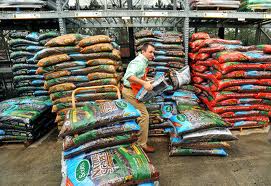 My annual springtime gardening experiment…
My annual springtime gardening experiment…
This past weekend, I was doing some backyard gardening in North Jersey- my futile attempt to convince myself that winter is over in the Northeast and that we are headed full-steam toward sunny skies and warmer temperatures. Of course, anyone who lives in this part of the country knows how useless this tactic is, as within a few days we’ll be back down into the 40s with rain. That is, until June when the weather will instantaneously switch to the hot and humid days of summer, bypassing spring entirely. But taking advantage of the nice weather, even if just for a day, would be worth it even if it were just for a few hours of sanity and relaxation, right? Not so fast.
Why exactly I choose “gardening” as a way to decompress is about as clear to me as why bad golfers choose to endure hours of hacking at a golf ball as a way to spend a nice Saturday afternoon. But just like the bad golfer who trades off four hours of frustration for what may be a few good shots, such is the case with me and my annual bouts with cleaning up the yard and getting it ready for better days ahead.
It all starts with the “Orange Aprons”…
The trend is usually predictable: The inescapable trip to fight the crowds at Home Depot (which I now rationalize as my contribution to improving HD stock performance), the often painstaking task of unpacking the purchases and unpotting the plants, and the ensuing hours of digging (usually through layers of rock which seem to “grow back” every winter), raking, planting, mulching, and the inevitable cleanup that follows well into the evening hours. But like the bad golfer who slices his first shot of the season into the woods, my annual gardening experience usually starts yielding frustration long before any planting begins, and sometimes even before I leave the Home Depot parking lot.

This year, the frustration took a little longer to materialize. In fact the entire shopping experience was pretty good. I had little difficulty finding what I was looking for, and the staff was both accessible and helpful. The lines moved quickly and I was out before I knew it. In fact, against the many dimensions I typically grade service providers on, I’d have to give the “orange apron guys” an A+. The day appeared to be turning out better than in years past. But I knew better. It was only a matter of time before that glorious Saturday afternoon would begin generating increased blood pressure and the collection of four letter words that accompanies it. Such would be the case upon my arrival home.
The dreaded “unpacking” phase…
After arriving home and convincing my teenage boys to unpack the car (yet another delightful surprise), I began the unpacking process. And, within an instant, the calmness and serenity that had occupied my mood changed to frustration and anxiety. For whatever reason, this year’s unpacking process appeared to me significantly more difficult. It started with the requisite layers of bubble wrap and tape that enveloped each component of new patio furniture we had bought. And when I say each component, I mean down to every individual nut and bolt!!! Then there was the military-grade plastic packaging that encased my new 10-dollar pruning sheers, protecting it from God knows what. (You know, the kind of packaging that requires the “jaws of life” to successfully extract). And then, there were all those damned “sticky” labels that invariably require countless hours of “picking” to effectively remove, lest your new purchase live the remainder of its useful life with its caregiver instructions and warning labels intact.
Now maybe I was just paying more attention this year, but it seemed as if the people responsible for packaging all this stuff were playing a big joke on yours truly. Just why companies feel compelled to spend 30 dollars on packaging to protect a 10-dollar garden tool is more than a bit perplexing. Ironically enough, every single product I bought had some kind of environmental or recycling message on it, which screamed hypocrisy given all of the trees and petroleum used to create (or recycle) these labels and packaging. But I digress.
Those damned “sticky labels”- ARGH!!!
This year, it was those damned “sticky labels” that threw me over the edge, particularly the ones affixed to each of the 10 segments of “garden border” I purchased. Those stickers appear to be everywhere these days, and some are admittedly easier to remove than others. I happened to be the recipient of the latter type. And yes, I KNOW that I can remove them with warm soapy water or Windex. But really…does EVERY 6 inch segment of garden boarder need three sticky labels conspicuously affixed to the visible side of it? To amplify the frustration, the garden border I purchased was sold in a 10 pack! 30 stickers in all, each requiring a few minutes of removal, lest I live with a perpetual banner of warning labels and bar codes around the border of my garden.
I couldn’t help but think how so many good products lose their impact because of such bad packaging decisions. Talk about a moment of truth! I can assure you that most of the products I purchased that day will be remembered by me, not for their uniqueness, robustness, or endurance,but rather for the annoying unpacking experience created by their unfriendly and obstructive packaging.
A bright spot amidst the madness…
 There was however one bright spot in the unpacking experience, At the bottom of the bag was an attractive ceramic outdoor oil candle my wife purchased- an inexpensive impulse buy, but still a nice centerpiece at a holiday BBQ or summer dinner party. The candle wasn’t boxed, as it was probably a Home Depot brand or otherwise “generic”. Affixed to the side of it was yet another single “sticky label”. Only this one was small and inconspicuous, and contained nothing but one of those square bar codes (what is known now as a QR code) with a note that suggested I “scan it” with my smart-phone for more info . Intrigued, I scanned it with my iPhone and it took me directly to a Home Depot web site that displayed an array of other outdoor products apparently related to my purchase which caused me to look at a few more products that were kind of neat. I bookmarked the page and removed the sticker (which was of the other, easy-to-peel variety). Overall, a very cool example of less being more.
There was however one bright spot in the unpacking experience, At the bottom of the bag was an attractive ceramic outdoor oil candle my wife purchased- an inexpensive impulse buy, but still a nice centerpiece at a holiday BBQ or summer dinner party. The candle wasn’t boxed, as it was probably a Home Depot brand or otherwise “generic”. Affixed to the side of it was yet another single “sticky label”. Only this one was small and inconspicuous, and contained nothing but one of those square bar codes (what is known now as a QR code) with a note that suggested I “scan it” with my smart-phone for more info . Intrigued, I scanned it with my iPhone and it took me directly to a Home Depot web site that displayed an array of other outdoor products apparently related to my purchase which caused me to look at a few more products that were kind of neat. I bookmarked the page and removed the sticker (which was of the other, easy-to-peel variety). Overall, a very cool example of less being more.
The rest of the day went pretty well. In fact, I am now wondering just how much of the past year’s angst was created by something as simple as the unpacking process. Did that part of the ordeal set the tone for the entire day? For me, and on this day, it most certainly did. And it got me thinking: How often is our frustration as consumers linked to one simple trigger event like this? Do the manufacturers and distributors of these products have any clue about the emotional chaos created by such simple, yet stupid packaging decisions? And why they would allow this to occur in such an early stage in the product experience?
What’s your “sticky label”?
Most of us have aspects of our product or offers that create the same kind of frustrating experiences. And just like the people who sold me the garden border, we probably don’t have a clue that these emotions are occurring as I write this.
So I ask you: What is your “sticky label”?
Author: Bob Champagne is Managing Partner of onVector Consulting Group, a privately held international management consulting organization specializing in the design and deployment of Performance Management tools, systems, and solutions. Bob has over 25 years of Performance Management experience and has consulted with hundreds of companies across numerous industries and geographies. Bob can be contacted at bob.champagne@onvectorconsulting.com



Bob, you’re not alone, my friend!
Packaging issues were apparently running rampant throughout the northeast this past week, as I experienced “wrap rage” in Portland, Maine, and like you, felt compelled to blog about it.( http://bit.ly/gEOVMu ).
Maz Iqbal ( http://bit.ly/dVTvy1 ) offered a good explanation for why these product packaging issues exist:
“My thinking is that the companies that supply the product (in this wrapping) are immersed in the traditional goods dominant logic where:
a) the role of the company is to produce and sell the goods. Once the sale is made then the company’s role in the process is finished;
b) value resides in the product not in the customer using the product. ”
Now, if we can only get the marketing guys to talk to the packaging and distribution guys, together they might make our lives easier.
‘Here’s to a great summer in “The Garden State!”
Jim Watson
Sticky labels are a great example. For me, it’s attitudinal. That smile, that attentiveness, that service delivery that make me feel like a valued customer. When the CSR is talking on the phone or with a coworker or have a messy work station, it hits a sticky label moment. And because I’m in this for a living, I treat the service folks with extreme kindness knowing how hard their jobs are – all the while grading more critically.